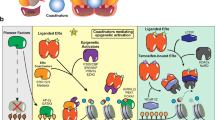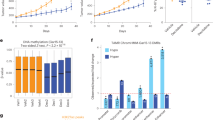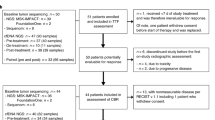Abstract
Approximately 75% of breast cancers express estrogen receptor α (ERα) and depend on estrogen signals for continued growth. Aromatase inhibitors (AIs) prevent estrogen production and inhibit ER signaling, resulting in decreased cancer recurrence and mortality. Advanced tumors treated with AIs almost always develop resistance to these drugs via the upregulation of alternative growth signals. The mechanisms that drive this resistance—especially epigenetic events that alter gene expression—are, however, not well understood. Genome-wide DNA methylation and expression analysis of cell line models of acquired AI resistance indicated that prostaglandin E2 receptor 4 (PTGER4) is upregulated after demethylation in resistant cells. Knockdown and inhibitor studies demonstrate that PTGER4 is essential for estrogen-independent growth. Our exploratory analysis of downstream signaling indicates that PTGER4 likely promotes AI resistance via ligand-independent activation of the ERα-cofactor CARM1. We believe that we have discovered a novel epigenetic mechanism for altering cell signaling and acquiring endocrine therapy resistance. Our findings indicate that PTGER4 is a potential drug target in AI-resistant cancers. In addition, the epigenetic component of PTGER4 regulation suggests that further study of PTGER4 may yield valuable insights into how DNA methylation-targeted diagnoses and treatments can improve AI-resistant breast cancer treatment.
This is a preview of subscription content, access via your institution
Access options
Subscribe to this journal
Receive 50 print issues and online access
$259.00 per year
only $5.18 per issue
Buy this article
- Purchase on Springer Link
- Instant access to full article PDF
Prices may be subject to local taxes which are calculated during checkout




Similar content being viewed by others
References
Harvey JM, Clark GM, Osborne CK, Allred DC . Estrogen receptor status by immunohistochemistry is superior to the ligand-binding assay for predicting response to adjuvant endocrine therapy in breast cancer. J Clin Oncol 1999; 17: 1474–1474.
Johnston SRD, Dowsett M . Aromatase inhibitors for breast cancer: lessons from the laboratory. Nat Rev Cancer 2003; 3: 821–831.
Musgrove EA, Sutherland RL . Biological determinants of endocrine resistance in breast cancer. Nat Rev Cancer 2009; 9: 631–643.
Dowsett M, Cuzick J, Ingle J, Coates A, Forbes J, Bliss J et al. Meta-analysis of breast cancer outcomes in adjuvant trials of aromatase inhibitors versus tamoxifen. J Clin Oncol 2010; 28: 509–518.
Ma CX, Reinert T, Chmielewska I, Ellis MJ . Mechanisms of aromatase inhibitor resistance. Nat Rev Cancer 2015; 15: 261–275.
Li S, Shen D, Shao J, Crowder R, Liu W, Prat A et al. Endocrine-therapy-resistant ESR1 variants revealed by genomic characterization of breast-cancer-derived xenografts. Cell Rep 2013; 4: 1116–1130.
Aguilar H, Solé X, Bonifaci N, Serra-Musach J, Islam A, López-Bigas N et al. Biological reprogramming in acquired resistance to endocrine therapy of breast cancer. Oncogene 2010; 29: 6071–6083.
Zilli M, Grassadonia A, Tinari N, Di Giacobbe A, Gildetti S, Giampietro J et al. Molecular mechanisms of endocrine resistance and their implication in the therapy of breast cancer. Biochim Biophys Acta 2009; 1795: 62–81.
Ellis MJ, Ding L, Shen D, Luo J, Suman VJ, Wallis JW et al. Whole-genome analysis informs breast cancer response to aromatase inhibition. Nature 2012; 486: 353–360.
Iorns E, Turner NC, Elliott R, Syed N, Garrone O, Gasco M et al. Identification of CDK10 as an important determinant of resistance to endocrine therapy for breast cancer. Cancer Cell 2008; 13: 91–104.
Kato S, Endoh H, Masuhiro Y, Kitamoto T, Uchiyama S, Sasaki H et al. Activation of the estrogen receptor through phosphorylation by mitogen-activated protein kinase. Science (New York, NY) 1995; 270: 1491–1494.
Le Goff P, Montano MM, Schodin DJ, Katzenellenbogen BS . Phosphorylation of the human estrogen receptor. Identification of hormone-regulated sites and examination of their influence on transcriptional activity. J Biol Chem 1994; 269: 4458–4466.
Feinberg AP, Ohlsson R, Henikoff S . The epigenetic progenitor origin of human cancer. Nat Rev Genet 2006; 7: 21–33.
Kulis M, Esteller M 2 - DNA methylation and cancerIn: Ushijima ZHAT (ed) Advances in Genetics. Academic Press: Amsterdam, Netherlands, 2010, pp 27–56.
Ottaviano YL, Issa J-P, Parl FF, Smith HS, Baylin SB, Davidson NE . Methylation of the estrogen receptor gene CpG island marks loss of estrogen receptor expression in human breast cancer cells. Cancer Res 1994; 54: 2552–2555.
Ferguson AT, Lapidus RG, Baylin SB, Davidson NE . Demethylation of the estrogen receptor gene in estrogen receptor-negative breast cancer cells can reactivate estrogen receptor gene expression. Cancer Res 1995; 55: 2279–2283.
Yang X, Phillips DL, Ferguson AT, Nelson WG, Herman JG, Davidson NE . Synergistic activation of functional estrogen receptor (ER)-alpha by DNA methyltransferase and histone deacetylase inhibition in human ER-alpha-negative breast cancer cells. Cancer Res 2001; 61: 7025–7029.
Yang X, Ferguson AT, Nass SJ, Phillips DL, Butash KA, Wang SM et al. Transcriptional activation of estrogen receptor alpha in human breast cancer cells by histone deacetylase inhibition. Cancer Res 2000; 60: 6890–6894.
Sabnis GJ, Goloubeva O, Chumsri S, Nguyen N, Sukumar S, Brodie AMH . Functional activation of the estrogen receptor-α and aromatase by the HDAC inhibitor entinostat sensitizes ER-negative tumors to letrozole. Cancer Res 2011; 71: 1893–1903.
Keen JC, Yan L, Mack KM, Pettit C, Smith D, Sharma D et al. A novel histone deacetylase inhibitor, scriptaid, enhances expression of functional estrogen receptor alpha (ER) in ER negative human breast cancer cells in combination with 5-aza 2'-deoxycytidine. Breast Cancer Res Treat 2003; 81: 177–186.
Giacinti L, Giacinti C, Gabellini C, Rizzuto E, Lopez M, Giordano A . Scriptaid effects on breast cancer cell lines. J Cell Physiol 2012; 227: 3426–3433.
Zhou Q, Shaw PG, Davidson NE . Inhibition of histone deacetylase suppresses EGF signaling pathways by destabilizing EGFR mRNA in ER-negative human breast cancer cells. Breast Cancer Res Treat 2008; 117: 443–451.
Sanchez CG, Ma CX, Crowder RJ, Guintoli T, Phommaly C, Gao F et al. Preclinical modeling of combined phosphatidylinositol-3-kinase inhibition with endocrine therapy for estrogen receptor-positive breast cancer. Breast Cancer Res 2011; 13: R21.
Crowder RJ, Phommaly C, Tao Y, Hoog J, Luo J, Perou CM et al. PIK3CA and PIK3CB inhibition produce synthetic lethality when combined with estrogen deprivation in estrogen receptor-positive breast cancer. Cancer Res 2009; 69: 3955–3962.
Chan CMW, Martin L-A, Johnston SRD, Ali S, Dowsett M . Molecular changes associated with the acquisition of oestrogen hypersensitivity in MCF-7 breast cancer cells on long-term oestrogen deprivation. J Steroid Biochem Mol Biol 2002; 81: 333–341.
Yokoyama U, Iwatsubo K, Umemura M, Fujita T, Ishikawa Y . The prostanoid EP4 receptor and its signaling pathway. Pharmacol Rev 2013; 65: 1010–1052.
Edwards JR, O'Donnell AH, Rollins RA, Peckham HE, Lee C, Milekic MH et al. Chromatin and sequence features that define the fine and gross structure of genomic methylation patterns. Genome Res 2010; 20: 972–980.
van Agthoven T, van Agthoven TL, Dekker A, Foekens JA, Dorssers LC . Induction of estrogen independence of ZR-75-1 human breast cancer cells by epigenetic alterations. Mol Endocrinol 1994; 8: 1474–1483.
Vanderkraats ND, Hiken JF, Decker KF, Edwards JR . Discovering high-resolution patterns of differential DNA methylation that correlate with gene expression changes. Nucleic Acids Res 2013; 41: 6816–6827.
Irizarry RA, Ladd-Acosta C, Wen B, Wu Z, Montano C, Onyango P et al. The human colon cancer methylome shows similar hypo- and hypermethylation at conserved tissue-specific CpG island shores. Nat Genet 2009; 41: 178–186.
Fritah A, Saucier C, De Wever O, Bracke M, Bieche I, Lidereau R et al. Role of WISP-2/CCN5 in the maintenance of a differentiated and noninvasive phenotype in human breast cancer cells. Mol Cell Biol 2008; 28: 1114–1123.
Holemon H, Korshunova Y, Ordway JM, Bedell JA, Citek RW, Lakey N et al. MethylScreen: DNA methylation density monitoring using quantitative PCR. BioTechniques 2007; 43: 683–693.
Kim JH, Kang S, Kim TW, Yin L, Liu R, Kim SJ . Expression profiling after induction of demethylation in MCF-7 breast cancer cells identifies involvement of TNF-α mediated cancer pathways. Mol Cells 2012; 33: 127–133.
Carascossa S, Dudek P, Cenni B, Briand P-A, Picard D . CARM1 mediates the ligand-independent and tamoxifen-resistant activation of the estrogen receptor alpha by cAMP. Genes Dev 2010; 24: 708–719.
Subramanian A, Tamayo P, Mootha VK, Mukherjee S, Ebert BL, Gillette MA et al. Gene set enrichment analysis: a knowledge-based approach for interpreting genome-wide expression profiles. Proc Natl Acad Sci USA 2005; 102: 15545–15550.
Ellis MJ, Tao Y, Luo J, A'Hern R, Evans DB, Bhatnagar AS et al. Outcome prediction for estrogen receptor-positive breast cancer based on postneoadjuvant endocrine therapy tumor characteristics. J Natl Cancer Inst 2008; 100: 1380–1388.
Miller TW, Balko JM, Ghazoui Z, Dunbier A, Anderson H, Dowsett M et al. A gene expression signature from human breast cancer cells with acquired hormone independence identifies MYC as a mediator of antiestrogen resistance. Clin Cancer Res 2011; 17: 2024–2034.
Creighton CJ, Li X, Landis M, Dixon JM, Neumeister VM, Sjolund A et al. Residual breast cancers after conventional therapy display mesenchymal as well as tumor-initiating features. Proc Natl Acad Sci USA 2009; 106: 13820–13825.
Ma X, Kundu N, Rifat S, Walser T, Fulton AM . Prostaglandin E receptor EP4 antagonism inhibits breast cancer metastasis. Cancer Res 2006; 66: 2923–2927.
Terada N, Shimizu Y, Kamba T, Inoue T, Maeno A, Kobayashi T et al. Identification of EP4 as a potential target for the treatment of castration-resistant prostate cancer using a novel xenograft model. Cancer Res 2010; 70: 1606–1615.
Forbes SA, Beare D, Gunasekaran P, Leung K, Bindal N, Boutselakis H et al. COSMIC: exploring the world's knowledge of somatic mutations in human cancer. Nucleic Acids Res 2015; 43: D805–D811.
Chen D, Pace PE, Coombes RC, Ali S . Phosphorylation of human estrogen receptor alpha by protein kinase A regulates dimerization. Mol Cell Biol 1999; 19: 1002–1015.
Tharakan R, Lepont P, Singleton D, Kumar R, Khan S . Phosphorylation of estrogen receptor alpha, serine residue 305 enhances activity. Mol Cell Endocrinol 2008; 295: 70–78.
Lazennec G, Thomas JA, Katzenellenbogen BS . Involvement of cyclic AMP response element binding protein (CREB) and estrogen receptor phosphorylation in the synergistic activation of the estrogen receptor by estradiol and protein kinase activators. J Steroid Biochem Mol Biol 2001; 77: 193–203.
Nguyen VT, Barozzi I, Faronato M, Lombardo Y, Steel JH, Patel N et al. Differential epigenetic reprogramming in response to specific endocrine therapies promotes cholesterol biosynthesis and cellular invasion. Nat Commun 2015; 6: 10044.
Zhang QX, Borg A, Wolf DM, Oesterreich S, Fuqua SA . An estrogen receptor mutant with strong hormone-independent activity from a metastatic breast cancer. Cancer Res 1997; 57: 1244–1249.
Toy W, Shen Y, Won H, Green B, Sakr RA, Will M et al. ESR1 ligand-binding domain mutations in hormone-resistant breast cancer. Nat Genet 2013; 45: 1439–1445.
Merenbakh-Lamin K, Ben-Baruch N, Yeheskel A, Dvir A, Soussan-Gutman L, Jeselsohn R et al. D538G mutation in estrogen receptor-α: a novel mechanism for acquired endocrine resistance in breast cancer. Cancer Res 2013; 73: 6856–6864.
Robinson DR, Wu Y-M, Vats P, Su F, Lonigro RJ, Cao X et al. Activating ESR1 mutations in hormone-resistant metastatic breast cancer. Nat Genet 2013; 45: 1446–1451.
Stone A, Zotenko E, Locke WJ, Korbie D, Millar EKA, Pidsley R et al. DNA methylation of oestrogen-regulated enhancers defines endocrine sensitivity in breast cancer. Nat Commun 2015; 6: 7758.
Trapnell C, Pachter L, Salzberg SL . TopHat: discovering splice junctions with RNA-Seq. Bioinformatics 2009; 25: 1105–1111.
Anders S, Pyl PT, Huber W . HTSeq—a python framework to work with high-throughput sequencing data. Bioinformatics 2015; 31: 166–169.
Robinson MD, McCarthy DJ, Smyth GK . edgeR: a Bioconductor package for differential expression analysis of digital gene expression data. Bioinformatics 2010; 26: 139–140.
Olson JA Jr, Budd GT, Carey LA, Harris LA, Esserman LJ, Fleming GF et al. Improved surgical outcomes for breast cancer patients receiving neoadjuvant aromatase inhibitor therapy: results from a multicenter phase II trial. - PubMed - NCBI. J Am Coll Surg 2009; 208: 906–914.
Ellis MJ, Suman VJ, Hoog J, Lin L, Snider J, Prat A et al. Randomized phase II neoadjuvant comparison between letrozole, anastrozole, and exemestane for postmenopausal women with estrogen receptor-rich stage 2 to 3 breast cancer: clinical and biomarker outcomes and predictive value of the baseline PAM50-based intrinsic subtype—ACOSOG Z1031. J Clin Oncol 2011; 29: 2342–2349.
Acknowledgements
We thank C de Guzman-Strong and S Matkovich for their comments on the manuscript. This work was supported by grants NIH R00 CA127360, NIH R21 LM011199, NIH 2T32GM007067-37, Department of Defense W81XWH-11-1-0401 and a Siteman Cancer Center Breast Cancer Program career development award to JRE. We also thank the Genome Technology Access Center at the Washington University School of Medicine for help with genomic analysis (partially supported by NIH P30 CA91842 and NIH UL1 TR000448).
Author information
Authors and Affiliations
Corresponding author
Ethics declarations
Competing interests
Dr Ellis has received consulting fees from Pfizer, Novartis and AstraZenica. He has ownership and patent income from Bioclassifier LLC for the PAM50 breast cancer test Prosigna sold by Nanostring. The remaining authors declare no conflict of interest.
Additional information
Supplementary Information accompanies this paper on the Oncogene website
Supplementary information
Rights and permissions
About this article
Cite this article
Hiken, J., McDonald, J., Decker, K. et al. Epigenetic activation of the prostaglandin receptor EP4 promotes resistance to endocrine therapy for breast cancer. Oncogene 36, 2319–2327 (2017). https://doi.org/10.1038/onc.2016.397
Received:
Revised:
Accepted:
Published:
Issue Date:
DOI: https://doi.org/10.1038/onc.2016.397
This article is cited by
-
Protein arginine methylation: from enigmatic functions to therapeutic targeting
Nature Reviews Drug Discovery (2021)
-
Prostanoid receptor genes confer poor prognosis in head and neck squamous cell carcinoma via epigenetic inactivation
Journal of Translational Medicine (2020)



